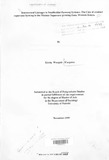| dc.description.abstract | This thesis is on the inter-sectoral linkages between the cash crop sector and other farm and
non-farm activities. It thesis examines and synthesizes evidence on how a relatively successful
and veritable cash crop sector may buoy the regional economy and the general quality of life
of the participating groups by stimulating growth in other sectors .
Using the microcosm of contract sugarcane farming in the Mumias Sugar - belt, the study
evaluates the extent to which relevant sugarcane farming technologies have been adopted for
food production and, how the resource base at the household level has been deepened and
enlarged through investment of the income accruing from sugarcane farming in other income generating
activities especially, the micro and small enterprise sector. The factors that inform
the emerging adoption and investment patterns are investigated.
Two bodies of knowledge namely, modernization theory and livelihood strategy theories are
adopted as the theoretical muscles for the study. In so doing, the process is conceived of as
fundamentally informed by the intricate interplay between, on the one hand, the paradigm in
whose rubric development efforts are initiated and, on the other hand, household decision
making, and how these are brought to bear on each other.
The study is based on a survey of 117 farmers drawn from the Mumias Sugar-belt and on
contract with Mumias Sugar company. Data were collected from randomly selected farmers
using a structured questionnaire. Focused group discussions (FGDs) and interviews with key
informants were also held. The quantitative, descriptive and statistical methods used in
presentation and analysis of data are frequency distributions, percentages, cross tabulations
and correlation and regression analysis.
Examination of study findings confirms the significant interface of sugarcane growing and
other farm and non-farm activities. In tandem with the theoretical framework adopted, the
offshoot of such interface is shown to be a consequence of the local socio-cultural economic
and institutional environment. The quality of farmership (derived from the farmers' socioeconomic
characteristics), the scale of production at the farm level and the performance of
local institutional delivery systems (Extension services and farmer organisations) inter alia
emerged as the most critical determinants of adoption and investment behaviour. However,
a closer look at the findings reveals that only 42 per cent. of the farmers have adopted the
technology of fertiliser use to the extent that they use it for food production while only 24.8
per cent of the farmers invest cane income in other income-generating activities.
Moreover, the study reveals the farmers', and indeed the areas, dependence on cane income.
Besides, because this income is consumed directly rather than invested into other income
generating activities, this dependency is poised to get even worse.
The study reports diminishing landholding compounded by large household sizes and argues
that given the practice of land inheritance via land subdivision, fewer farmers will be in a
position to engage in effective sugarcane farming. It is therefore instructive that farmers start
preparing for the post sugarcane growing era by investing cane income, and indeed any other
income, in income generating activities . In view of the foregoing, the study observes that
small farmers in the Mumias sugar-belt will now, more than ever before, depend on off-farm
income for an adequate level of living. To focus on programmes specifically for agriculture
and to ignore the off-farm sector especially the micro and small enterprise development, as
has been the case this far, is not in the best interest of the small farmers. Further, the study
underscores the critical role of the interplay between farmer and household characteristics,
local capacity building institutions and scarce factors of production - land, technology,
capital, skills and knowledge. In cognisance of this, the study posits that the way forward is
for the establishment and cultivation of a vibrant civil society and community based
organisations which will serve as the focal base for influencing socio-cultural and economic
values and attitudes and, for the dissemination of knowledge and formation of skills and
practices necessary to mobilize and maximize the productivity of local resources, and to
stimulate entrepreneurship. | en |

